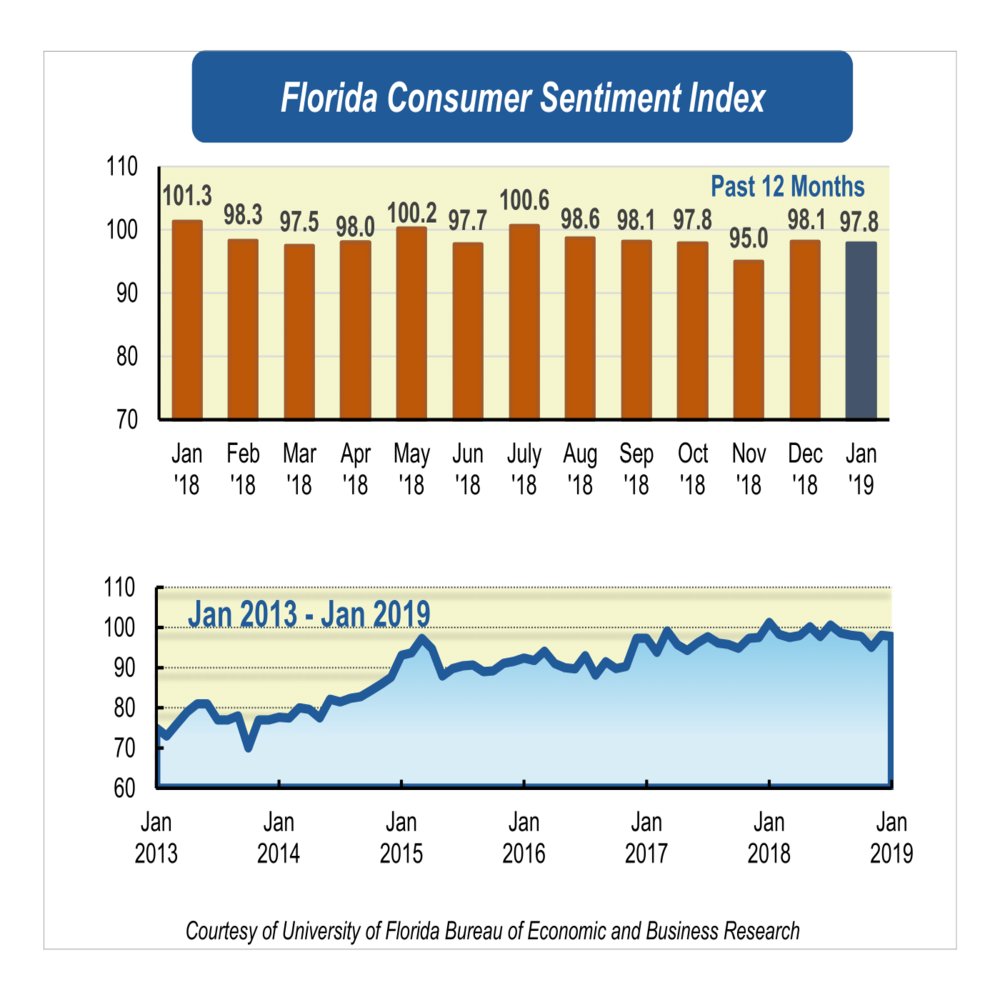Mix in attitudes causes slight dip in January’s consumer sentiment

Consumer sentiment among Floridians fell three-tenths of a point to 97.8 in January from a revised figure of 98.1 in December and is down 3.5 points from a year ago.
Of the five components that make up the index, two decreased and three increased.
Floridians’ opinions about current economic conditions were mixed. Perception of one’s personal financial situation now compared with a year ago increased 6.1 points from 88.1 to 94.2, the greatest increase of any reading this month. This opinion is shared by all Floridians across sociodemographic groups but is stronger among those with income under $50,000.
On the other hand, opinions as to whether now is a good time to buy a major household item such as an appliance showed the greatest decline in this month’s readings from 109.6 to 99.8, a change of 9.8 points. This opinion is shared by all Floridians but is stronger among women and those aged 60 and older.
“Although these two components of the index moved in opposite directions, together they showed that opinions regarding current economic conditions deteriorated among Floridians in January,” said Hector H. Sandoval, director of the Economic Analysis Program at UF’s Bureau of Economic and Business Research.
Outlooks about future economic conditions were also mixed. Expectations of personal finances a year from now increased three points from 106 to 109, while anticipations of U.S. economic conditions over the next year decreased nine-tenths of a point from 94 to 93.1. Finally, expectations of U.S. economic conditions over the next five years increased slightly, two-tenths of a point from 92.8 to 93.
“The pessimistic views about the short-term outlook on the U.S. economy are not shared by all Floridians. Those aged 60 and older and those with incomes under $50,000 maintain strong positive expectations. Furthermore, even though this component of the index decreased, overall expectations about future economic conditions increased in January,” Sandoval said. “Most of the pessimism in January stems from the negative expectations regarding Floridians’ opinions as to whether now is a good time to buy a big ticket item.”
During the last year, after seeing the realized and expected labor market conditions and inflation, the Federal Open Market Committee increased the target range for the federal funds rate. In June, the committee increased the range to 1.75 to 2 percent, in September to 2 to 2.25 percent, and in December to 2.25 to 2.5 percent.
“Although these changes in the federal funds rate might take time to spread through the economy, they are gradually increasing the cost of borrowing by affecting other interest rates such as bank loans, mortgages and credit cards. As a result, they might explain some of the changes observed regarding the opinions as to whether now is a good time to buy a major household item,” Sandoval said.
Florida’s economic conditions remain favorable, with more jobs added in December. According to the latest report from the Florida Department of Economic Opportunity, the state gained 231,200 jobs over the year in December, an increase of 2.7 percent. Among all industries, education and health services gained the most jobs, followed by leisure and hospitality, professional and business services, and construction. The unemployment rate was 3.3 percent, unchanged from the November rate, and closer to the historical observed minimum of 3.1 percent in March 2006.
“Despite the slight decline, consumer sentiment continued to be high in Florida. In view of the realized economic outlook, particularly in the labor market, it is unlikely that federal funds rate changes will undermine the current economic expansion,” Sandoval said.
Conducted Jan. 1-24, the UF study reflects the responses of 426 individuals who were reached on cellphones, representing a demographic cross section of Florida. The index used by UF researchers is benchmarked to 1966, which means a value of 100 represents the same level of confidence for that year. The lowest index possible is a 2, the highest is 150.
Details of this month’s survey can be found at http://www.bebr.ufl.edu/csi-data